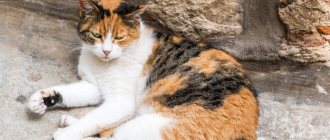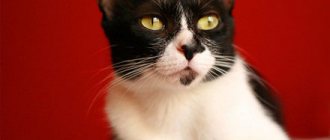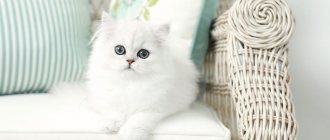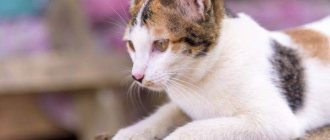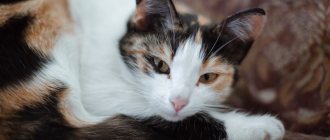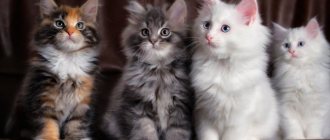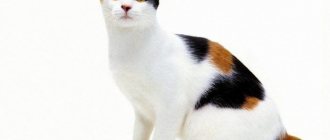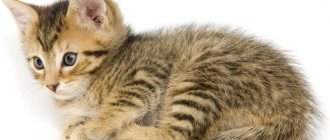A luxurious fluffy coat, an easygoing and peaceful disposition, an expressive look and extraordinary devotion to the owner - these are just a few of the advantages of cats of the Persian breed, which is one of the most popular in the world. Keeping a Persian pet in the house is true happiness for any cat lover.
And even the fact that the fluffy fur of this handsome cat requires special attention, and his unusual physiology requires specialized nutrition, does not stop numerous fans of Persians. Moreover, with due care and attention, a cat of this noble origin will live a long and happy life in the family of its human, bringing joy to both adults and children.
What is he like, a Persian cat? What are the Persian breed standards? What does this cute fluffy like and what doesn’t? How to create comfortable conditions for your pet, provide a healthy diet and, of course, make friends with him for many years? We'll tell you everything without embellishment.
Child of star, fire and smoke
The history of the emergence of Persian cats, framed by mysterious myths, has its roots in the distant past. For example, one of the most famous and poetic legends says that once a magician was attacked by robbers, but, fortunately, the hero Rustam was nearby, who freed him. The grateful wizard asked his savior what to give him as a gift. However, the modest Rustam replied that all he needed was the starry sky above his head and a fire emitting a pleasant aroma of smoke.
Then the magician called to himself a small spark of fire, added a gray curl of smoke to it and removed the two most distant and brightest stars from the sky in order to obtain from these magical ingredients a small Persian kitten, which he gave to the brave Rustam as a companion. This legend explains how the Persian cat became the owner of long hair that flows like smoke, sparkling intelligence and starry eyes.
pixabay.com/maxmann
Mating and breeding
To get healthy offspring, it is necessary to take a responsible approach to the issue of breeding Persian cats. Basic Rules:
- Readiness. The female is usually ready for mating at the third heat (about a year), but if the timing is not pressing, it is advisable to wait until 1.5 - 2 years. This will give you a better chance of getting healthy kittens.
- Correct selection of the male. The cat must be completely healthy. It is advisable to familiarize yourself with his pedigree and veterinary passport to make sure that he does not have genetic diseases.
- Preparation. Both partners must be properly prepared. They should be given an anthelmintic a month before mating, and vaccinated 2 weeks before. The cat's nails need to be trimmed to prevent injury to the cat.
The cat is brought to the cat's territory, where mating will take place. This usually takes 2 days. Together with the cat you need to bring all its dowry: a house, bowls, a tray. This way she will feel freer and more comfortable.
Usually the cat does not let the cat get close at first; it can take several hours to get used to him and the new environment. Its readiness is indicated by its characteristic position: it bends down, lies on its front paws and raises its tail. Upon completion of the process, the cat may become aggressive and even attack the male, but this quickly passes. If mating is successful, the expectant mother will be happy to roll on the floor on her back.
Persian cats and female cats have romantic relationships when they sleep together, eat, lick each other and show their affection in other ways.
Pregnancy in a Persian cat lasts for 2 months (63–65 days). Most often it occurs without complications. However, the expectant mother needs to be provided with adequate, balanced nutrition and safety, because she becomes clumsy and may fall from a high shelf or cabinet.
By the end of the third week you can see a small round belly. In another week, the cat’s nipples will swell and become brighter. A week before giving birth, when milk begins to arrive, they will increase in size even more.
The owner needs to prepare a secluded place for the pet where she will give birth. It could even be a cardboard box with soft, clean bedding placed at the bottom. This house needs to be made in advance so that the cat understands what it is for and takes a liking to it.
During childbirth, it is better not to disturb the cat, but if it is too attached to its owner, then it is possible and even necessary to be present nearby. There are situations when a cat will need emergency help from the owner or even a veterinarian, so you shouldn’t completely forget about it. During contractions, you need to talk kindly to the cat, stroking her back, if she allows. This will help her give birth faster.
Childbirth usually lasts about a day. During this time, 3–6 kittens are born. If labor is prolonged and the cat cannot give birth, then you need to urgently call a veterinarian, otherwise death is possible. However, this happens extremely rarely.
Initial mentions of the Persian breed and its further history
They say that the first time Persian cats were mentioned was in travel accounts dating back to 1620: they said that a couple of unusually wooly cats were transported from the Iranian province of Khorasan straight to Italy. The “culprit” for the appearance of the Persians in Europe was the Italian Pietro Della Valle . Outwardly, these fluffy creations of nature were very different from traditional catfei, so they immediately aroused considerable interest in aristocratic circles.
According to another version, one of the discoverers of the breed in Europe was the French astronomer Nicolas-Claude Fabry de Pieresque . It was he who brought the Persians to his homeland from Turkey and called them Angora cats, since in those years it was believed that the Persians were the result of crossing an Angora with an Iranian cat.
Today, the breed is still called Persian, largely due to the detailed study of descriptions of the way of life of Ancient Persia by the Dutchman Van de Werff . In the 19th century, breeders from Germany took on the appearance of fluffy cats, trying to improve the quality of Persian fur and make the body of these cats less squat. And already in the 20th century, American breeders took up the Persian cat: they “gave” the breed its famous “face” with deep and intelligent, but childishly naive eyes.
Researchers have repeatedly transferred the “palm” with regard to the emergence and origin of the Persian cat breed from state to state. For example, the Irish were convinced that the ancestors of modern Persians were animals from the steppes of Asia and Africa. In France and Germany, many believed that the Persian cat was the domestic embodiment of the wild manul. As for the British, for a long time they persistently called long-haired Persians “French”.
By the way, the length of the fur of Persian cats also has many different explanations, because in those days many asked themselves the question why the coat of cats brought from hot climates was so thick and warm. One of the most plausible versions is the arrival of Persian cats to eastern countries from Siberia. Indeed, there is an obvious similarity between Siberian and Persian cats - just take the tufts of hair between the fingers, which are present in both breeds. One way or another, these cute fluffies living in our homes today were brought to the standards of the modern Persian breed by English breeders.
pixabay.com/cromaconceptovisual
Interesting facts about the breed
The Persian cat breed differs from other breeds not only in appearance, but in the history of their development there are many interesting facts.
- Back in 1901, the first club of blue Persian cat lovers was created in Great Britain, where at first only blue-eyed specimens were recognized, but then yellow-eyed ones were also included in the standard.
- In the USA, since 1935, breeders began to breed long-haired Persian colorpoints. The first kitten with the nickname Debutant marked the beginning of the breed of cats with a Siamese pattern, but similar to the Persians.
- Persian cats were the favorites of Queen Victoria, who was inseparable from them. Following her, all the court ladies acquired blue Persians.
- Snow-white cats with blue eyes are often susceptible to a genetic disease. They are more likely to be deaf from birth.
- Chinchilla cats have a defect in the form of a short tongue, so they do not lick themselves.
- Persians are different from other cats in that they love grooming and take great pleasure in being brushed.
Of all the variety of amazing cat breeds that exist, many people around the world prefer the cute snub-nosed Persians.
What does a Persian cat look like?
The description of the Persian cat breed, according to international WCF standards, is impressive, because it allows you to recognize this cat even to those who have never met him. The body of the animal is medium to fairly large in size and looks compact, short and squat. The height of the domestic Persian cat does not exceed 30 cm, the typical weight of females is 3.8-5 kg, and males - 5-7 kg. These cats reach standard height and weight no later than a year and a half after birth. The Persian's paws are rounded, complemented by the already mentioned tufts of hair between the toes. The animal's limbs are strong and thick, its shoulders are massive, its chest is strong, and its neck is powerful. All this is harmoniously complemented by well-developed muscles.
The Persian cat's head is round, the animal's forehead is convex, and its cheeks are full. The wide chin and large lower jaw of the cat are in perfect harmony with the wide muzzle. A characteristic feature of the Persian is also a funny short and wide nose, on which a fossa is clearly visible (or, in scientific terms, a stop). The look of the Persian cat is very expressive: intelligent, open and seemingly questioning, and its small rounded ears are placed low on the head and quite far apart from each other. The tail of the animal is significantly pubescent, but it itself is thick and short, covered with long hair, as is the entire body of the cat.
The fur of the Persian cat, although long, is quite thin. It is also unusually thick and silky. All this suggests that the breed, alas, is by no means hypoallergenic. And finally, Persians are real record holders for the number of officially registered recognized colors: there are over a hundred of them. It can be a pure white, gray, black, orange Persian cat, an animal with a color point color, a tabby, a bicolor, a smoky cat, and many other bright or muted variations of shades, which generally make up a multi-colored fluffy kaleidoscope.
Colors
In terms of the number of color types, the Persian cat will give odds to all other breeds, and all of them are officially recognized.
According to the exhibition rules, they are divided into 5 types:
- Single color;
- Smoky tabbies;
- Shaded;
- Partially painted;
- Point colors.
The photo shows a white Persian cat.
Common shades:
- The coat is black, the eyes are copper or orange. Impurities of a different color are not allowed, and patterns are not allowed. There may be a gray undercoat.
- Blue-eyed color-point with the obligatory cream shade of the body.
- Snow white with blue or orange eyes.
- Blue with yellow eyes.
- Fawn-cream color, copper color. Eyes the color of the fur. The presence of spots on the fur is not allowed.
- Red – rich, uniform orange with copper eyes.
- Bluish cream with copper eyes.
- Snow-white, apricot or smoky silver coat with brown or black tips. The eyes are green, outlined in black. The same subgroup includes lilac, blue and chocolate chinchillas.
- Persian Cameo (color can be yellow, cream or tortoiseshell) with copper-colored eyes.
- Smoky color, light silver undercoat. The eyes are orange.
- Two-color Persians, one of the colors must be white (no more than 50% of the total color). Copper eyes. A small number of colored spots are allowed.
- Tabby - silver, brown, red, chocolate, lilac, blue. Eyes copper, brown, emerald.
- Tortoiseshell color: a combination of spots of blue, chocolate, black, red and cream. Copper eyes. Mixing with white is allowed. The muzzle may have a red or cream tint.
- Pewter (pewter) - a mixture of white with shadows on the back and paws. The eyes are outlined in black and light orange.
- Pale lilac with a pink tint, copper eyes, outlined in black.
- Chocolate color of different shades, copper eyes.
- Marbled black with dark orange or copper eyes. The eyes are lined with black.
- Ivory color with bluish ticking, eyes lined, orange or copper.
- Black Spotted: The spots are oval or round, evenly distributed over the body, the eyes are outlined in black. Eye color is copper or dark orange.
- Black marbled with a silver body tint. The eyes are copper, outlined in black.
- Snow-white undercoat with a dark tint, green eyes of all shades, eyes outlined in dark.
In the photo there is a gray Persian cat
What types of Persian cats are there?
As a rule, among Persians there are a number of varieties endowed with certain features of the exterior and color. For example, a Persian cat of the “classic” type is similar to an ordinary cat. In particular, its nose is located in the same way slightly below eye level - up to 2 cm. This variety is considered outdated and is most similar to the original appearance of the Persian cat: slightly flattened face, slight snub nose, etc.
Nowadays, breeding of “classics” is carried out mainly in European countries and these animals are called the “European” type of Persians. Another type - extreme - has a significant snub nose and flattened muzzle. Also, this species is characterized by large deformation of the jaws, and the animal’s nose is quite strongly “sunk” into the skull.
A peculiar hybrid of a Persian cat and a short-haired American breed is called exotic: with its muzzle it somewhat resembles an extreme cat, but it still has a thick, but short fur coat. And as a result of crossing the classic and the extreme, an intermediate type was obtained - the short-nosed Persian. In addition, the Persian cat became the ancestor of a young and quite interesting breed of domestic cats, bred in 1987 - the Selkirk Rex.
It is worth mentioning separately about the Persian chinchilla: this cat, contrary to popular belief, is neither a variety of Persians nor a separate breed. In fact, chinchilla is just the name of an amazing color that turns the fur of Persian, as well as British and Scottish cats into a golden or silver coat, slightly covered with a charming dark haze.
pixabay.com/damien666
Differences in appearance and character: Persian, British Longhair and exotic
| Persian cat | British longhair cat | Exotic shorthair cat | |
| Peculiarities |
|
|
|
| Character |
| isolated and independent, calm temperament | calm, affectionate and friendly character |
| Difficulties |
|
| Grooming does not require much effort and time; dense wool does not need to be combed frequently |
| Dimensions | Average weight 3-5 kg, male 4-6 kg | Average weight 4-7 kg | The average weight of females is 5 kg, males up to 7 kg |
| Nutrition | Many prohibited foods due to digestive characteristics | The amount of food should be strictly measured, prone to overeating | They are demanding on the diet, most often they use specialized industrial feed of super-premium class and higher |
Characteristics and habits of Persian cats
The Persian cat is not only immensely charming, but also very obedient, so from a young age he will simply fit perfectly into any home environment. The docile nature of this animal allows it to easily understand and accept the rules of behavior dictated by the owner of the home.
Raising a kitten takes place without unpleasant surprises, since close contact quickly arises between it and its loving owner. As the Persian pet grows up, it lends itself well to simple training, which can bring it even closer to humans. And numerous reviews from the owners of these luxurious animals testify to the extraordinary intelligence and intelligence of the Persians, as well as their affectionate nature. That is why these fluffies take any disapproval or rudeness from the owner very close to the vulnerable cat’s heart.
The whole family can be endlessly touched by the habits of Persians, especially since the baby is ready to make friends with both its younger members and other pets - from hamsters to parrots. Children also love to tinker with shaggy cats, however, the latter should still be explained that they should not bother the cat too much with affection if he is not very inclined towards them at some point.
Pros and cons of the breed
| pros | Minuses |
|
|
Features of caring for a Persian cat
The main difficulty that the owner of a Persian cat faces in the process of caring for him is, of course, tidying up the animal’s fur. It is extremely long, and therefore requires daily attention in the form of combing. Otherwise, tangles will very soon form on your Persian’s fur coat and there will be no opportunity to sort out the tightly woven fine hairs.
To make combing easier, some breeders recommend adding a little talc to the coat. Fortunately, the Persian cat treats grooming with understanding and quickly gets used to it, since they begin to care for it already from the tender age of a kitten. But this fluffy doesn’t really like to wash, but for the sake of the external beauty and health of the coat and skin, you still have to do it - with the help of special shampoos. And one more important point: since a clean animal, despite careful care from the owner, still often licks its fur coat, it is advisable to give the pet a special paste so that the numerous fur that gets into the stomach does not cause harm to your pet.
A Persian cat's claws can be trimmed once every couple of weeks. We assure you: due to the calm nature of the pet, this procedure in most cases will not cause problems for the owner.
pixabay.com / @lindarczyk
Care and maintenance
The Persian cat is an elite breed. Keeping such an animal will require a lot of attention and considerable financial expenses from the owner. You are unlikely to find any other cat that would be as dependent on a person as the Persian. In order for your pet to always be beautiful and healthy, you will have to provide him with proper care, balanced feeding and proper support from an experienced veterinarian.
As for the living space, everything is more or less clear here. Persian cats are very calm and pliable; they like to spend a lot of time either in the arms of their owner or in a cozy, comfortable place allotted to them. They will easily get used to both the conditions of a city apartment and a large country house. The main thing is that family members do not forget about the animal.
Owners of private houses do not have to worry about their cat getting lost when going out for a walk. Persian cats are exceptional homebodies, and walking outdoors is not one of their favorite activities.
These cats are not hunters at all. Due to their phlegmatic nature, they get along well with other pets, including birds and rodents.
The Persian cat really values comfort and coziness. If opportunities allow, purchase a special sleeping place for your pet - a house or a bed. Your concern will definitely be appreciated. A soft chair or sofa will be a completely acceptable alternative for the animal. In this case, you should exercise caution and attentiveness, especially with a kitten. You can inadvertently injure your baby if he sleeps in your bed or likes to lie in the chair in which you are used to reading newspapers or watching TV.
Clipped Persian cat
Persian cats are very impressionable creatures. Never force your pet out of its home. If the cat is resting, do not touch it. Wait until your beauty wants to go outside on her own; in extreme cases, lure her with her favorite treat or interest her with a toy.
If your cat's house is not equipped with a scratching post, make sure to purchase one additionally. Ask the breeder what type of accessory the kitten is familiar with and buy a similar product. To train your little Persian to sharpen his claws in one place, use catnip. If you notice your animal's desire to get a manicure, immediately take it to a certain place. Persian cats are very intelligent creatures and will quickly figure out what you want to achieve from them.
Like any cat, a representative of the breed is very clean and will definitely try to bury the products of its vital activity. Persians can dig around in the litter box for a very long time before going to the toilet. To avoid being irritated by the filler scattered around, purchase a large tray with a high side (at least 10 cm). Prefer granular filler with high absorption capacity over wood filler. Immediately buy a tray designed for an adult animal. It will be convenient for the kitten to do his business in it, and when he grows up, he won’t have to spend money on a new one. The toilet can be placed on a larger rubberized mat. This will make cleaning up after your pet much easier.
An important accessory is a special carrying bag. You will need it for a visit to the veterinarian, for a trip to an exhibition, and when moving from a city apartment to a country house. The accessory must be suitable in size for the pet so that the animal feels comfortable enough inside.
White Persian cat
Thanks to its thick, long hair, the Persian cat tolerates the cold well, but it is still worth taking some preventative measures to avoid colds. Do not place the cat house or bed near entrance doors, windows or other places where drafts are possible. And if your pet prefers to spend time lying on the windowsill, lay a soft, warm cloth for him.
Just try to take my chicken
In matters of nutrition, almost all breeders without exception recommend choosing ready-made food of the highest quality category. Precisely calculated and well-balanced daily intakes will provide your cat with everything it needs, even without adding natural products to the diet. Mixed or natural feeding is more troublesome, since sometimes there is not enough time to prepare food for the cat separately, and the human menu is not suitable for it by definition. Seasonings, sugar, and salt in excess quantities can cause serious harm to the cat's body. Be sure to introduce special vitamin supplements with a seaweed complex into your cat’s diet in the required proportions (1 tablet with calcium + 3 tablets with algae extract or vice versa - depending on color) (for any type of feeding). The availability of freely available clean water is not even discussed.
Persian cats are prone to overeating, so you need to control their diet and under no circumstances feed them from your table or from your hands.
The special pride of the Persian cat is its fur. Caring for her is an art. You will need various tools - a rare comb with rounded teeth, a natural bristle brush, regular hair cutting scissors. During seasonal shedding, a special spray for removing fur may be useful.
Milaha
The structure of the animals' fur is such that without systematic care, tangles form very quickly, which can only be gotten rid of in a radical way. To avoid such troubles, some owners comb the animal daily and rarely bathe it, while others, on the contrary, often use water procedures followed by styling the fur. You can choose your path only through experimentation. The main thing is systematicity and constant adherence to the chosen procedure.
For the purpose of prevention, it is recommended to sprinkle the fur with a special grooming powder purchased at a pet store. Baby powders are not suitable: they contain starch, which is harmful to the cat’s body, and the cat will definitely swallow it while licking itself.
Do not use a slicker when caring for the hair of a Persian cat - the undercoat hairs of this breed are restored very slowly. Do not comb your pet's tail unless absolutely necessary.
Caring for the Persian cat's ears and teeth is standard, but the animal's eyes require a little more attention. They need to be cleaned daily, but not with cotton wool, but with a clean soft cloth moistened with special drops or distilled water. Do not use any wet wipes!
The animal should be bathed in warm water (depth no more than 10-12 cm) using special shampoos, avoiding getting the head wet. As a precaution, apply special drops to the Persian cat's eyes and place cotton swabs in the ears.
Considering the natural laziness of Persian cats, it is necessary to play with them to keep fit: with kids - 3-4 times, with adults - 1-2 times a day.
Health status of Persian cats
Unfortunately, all living creatures are endowed with a tendency to various kinds of diseases and painful conditions, and the wonderful Persians are no exception. A common problem for the breed is polycystic kidney disease, a disease that in some cases causes kidney failure in adult cats and older animals. By carefully monitoring your pet's health, you can avoid missing the first symptoms and consult a doctor in time. In addition, it is important to pay attention to the condition of the animal’s heart, since Persian cats often develop cardiomyopathy.
The Persian breed is quite large, so these animals also occasionally experience joint problems. But most often, Persian owners are concerned that their pets have watery eyes. This is due to the special structure of the muzzle, due to which the tear streams are blocked almost completely, which makes the Persian a “crybaby”. You can overcome this cosmetic defect by regularly washing your cat's eyes with a clean, soft cloth. You can also alternate this procedure with treating the area around the eyes with a solution of hydrogen peroxide with the addition of starch and boric acid. If, despite good care, the animal’s eyes fester or the discharge turns brown, you should immediately contact a specialist. It should also be noted that vaccinations done in a timely manner, in accordance with the schedule, will protect your pet from many health problems.
pixabay.com/uadrienn
Catering
Both experienced breeders and doctors say one thing: Persians should be fed in accordance with their health and age. From an early age, teach your cat to eat at a certain time.
Natural products
- Kittens feed on demand for up to a month;
- 1-2 months – eat 6 times a day;
- 2-4 months – 4-5 times a day;
- 4-6 months – 3 times;
- From 6 months – 2 times a day.
Daily food intake: 250 g per kilogram of live weight. For an adult cat – 300-350 g.
The first complementary food for a Persian baby is porridge cooked in diluted milk. From 3 months you can give frozen meat (naturally, before eating it is defrosted, doused with boiling water and minced). Serving – 0.4 teaspoon.
From 5 months, fermented milk products (natural yogurt, cottage cheese, low-fat sour cream, kefir, fermented baked milk), quail eggs, chicken yolk, and vegetables are introduced. You can also give children's cereal-vegetable mixtures.
Dry and wet food is allowed from 6 months. At first, the pads can be soaked in broth.
The diet of an adult cat should include:
- Meat (veal, rabbit, lamb, chicken, beef) – 50-60% of the total diet;
- By-products (chicken hearts and kidneys, raw cow stomach);
- Sea fish (salmon, hake, trout, cod) - no more than once a week;
- Vegetables (carrots, beets, green beans, pumpkin, cauliflower, zucchini) – every other day;
- Cheese (unsalted): once a week;
- Porridge (oatmeal, rice, buckwheat, millet, barley, for kittens up to 3 months - liquid semolina) - daily;
- Clean warm water: freely available (it is changed in the mornings and evenings).
Do not give to Persians:
- Milk
- Fatty meat (pork, goose),
- Smoked, salty, sweet, canned,
- Sauces, seasonings, spices,
- Baking,
- Bones and tripe
- Alcohol, carbonated and mineral water,
- Eggplants, potatoes, garlic, onions,
- Fat cottage cheese.
Recommended food
The best industrial food for Persians:
- German food based on poultry meat, vegetables and rice Sanabelle.
- Italian Purina Pro Plan Delicate: food for sensitive digestion (40% protein, there is also a vitamin complex).
- Royal Canin Persian (Royal Canin, France): contains chicken, cereals and vegetables.
- Orijen Cat 6 Fresh Fish comes in the form of granules with a fishy smell that is pleasant to the cat. Contains a vitamin complex.
Expert opinion
Dusheba Vera Ivanovna
In 2010, she graduated from the Moscow State Academy of Veterinary Medicine named after K.I. Scriabin with honors, specializing in veterinary medicine. I regularly attend veterinary conferences, congresses, and webinars.
Industrial feeds are divided into 4 groups: economy, premium, premium and holistic. You should buy economy class food only as a last resort: they are poor in nutrients and protein, contain harmful dyes and additives, and can ruin your pet’s stomach in a short time. Premium food is somewhat richer in composition, but the amount of meat in them is minimal, there are preservatives that are harmful to health, and often cause allergies. Premium class and holistic are the most suitable options: they contain the required amount of protein and fiber, and add all the necessary vitamins and minerals.
Below are recommended super premium foods, links with food names are clickable. Using them, you can, within our website, read descriptions of food and read reviews from owners of the Persian cat breed.
| Premium | Premium | Holistic |
| Pro Plan | Royal Canin Persian | Golden Eagle |
How to buy a Persian kitten
Since the Persian breed of domestic cats is extremely popular, this is often used by non-professionals who do not bear any responsibility for the health of the kitten and its hereditary data. That is why, in order not to get into trouble, you should not purchase a Persian kitten on dubious Internet sites, through virtual bulletin boards, etc. In addition, you need to make sure that the breeder has such important documents as the baby’s pedigree and veterinary passport. A reputable cattery will also show you the peach's parents, as well as its siblings, so you can see for yourself the good health of the entire feline family.
The price of a Persian cat depends on its class: the most budget-friendly animal will be the pet class, while a representative of the show class will cost you the maximum amount. The cost of a classic and extreme Persian is approximately the same.
Character of the Persians
The obedient Persian is known for being quiet and sweet most of the time. They are affectionate and picky, they give all their attention to their owner, but at the same time they are wary of house guests.
Important! Persian cats make excellent companions for their owner's family - they are calm and do not fuss unreasonably.
The Persian cat's personality is very calm; loud environments are frowned upon. Their usual needs and activities include eating, playing with toys, and napping during the day. And the most important thing for them is a lot of love, which a caring owner will be able to give to her by carefully combing her fur.
Such cats are unlikely to jump on your curtains or chew your wallpaper. While the family is not at home, the quiet cat prefers to be the decoration of the chair, waiting for his evening portion of care.
Famous Persian cats and their “people”
The Persian cat in the photo and in life is a real queen. However, these animals are not only photogenic: furry cats are also very popular in real movies. Moreover, they get different roles, ranging from sophisticated murderers to good wizards. For example, the white Persian Mr. Tinkles appeared in the film “Cats and Dogs” as a treacherous conqueror of the world. The complete opposite of the villain is the cat Crookshanks, Hermione Granger’s favorite pet, endowed with a lively mind, nobility and self-esteem.
By the way, about dignity. It is not for nothing that Persian cats are considered royal cats. Queen Victoria was not only the owner of Persians, but also the patroness of this breed. Marie Antoinette and two royal Louis , XIV and XV , kept Persian pets in their chambers .
In Russia, peaches became the pets of Anastasia Volochkova , Valery Meladze , and also Yuri Antonov . And, of course, speaking about Persians and their star owners, one cannot fail to mention the leader of the legendary group Queen, Freddie Mercury . He also adored and adopted these cutest cats. Perhaps the reason for the singer’s special love for them was his Persian origin.
pixabay.com/taurus9876
Persian longhair breed
| Breed name | Persian longhair cat (Persian) |
| Path of occurrence | Aboriginal breed with further development |
| Country of origin | Armenia, Iran, Türkiye |
| Coat | Longhair |
| Lifespan | 15 – 20 years |
| Cost of a kitten | 5 – 15 thousand rubles. |
How to choose a name for your Persian pet
Agree, it’s hard to call the fluffy pet of noble Persian blood Vaska or Murka. However, do not rush to give him any of the “royal” nicknames. It is wisest to first observe the animal, paying attention to its color, behavior and other points that may give you a good idea in the process of choosing a name. Perhaps, while dreaming of purchasing a cat, you unexpectedly earned a very large sum of money. So why not immortalize this significant event by naming your pet, for example, Baksik, Funtik or Mani?
The name of your Persian cat can also indicate your profession or hobby: for example, if you are a programmer, then an excellent name for a furry pet companion could be Linux, Flash Drive, Simka or Pixel and so on, depending on your imagination. So sometimes a pet’s name tells a lot more not about the animal itself, but about its owner: his lifestyle, taste, welfare, education and even age.
As for the nicknames associated with the character, appearance and other features of the cat, as well as euphonious “royal” names, among them we can distinguish, for example, Raf, Barkhan, Nils, Marcus, Simba, Casper, Lucky, Sherlock or even Peach for boys and Snezha, Joly, Tesla, Vax, Ollie, Leda, Fairy, Skoda or Athena for girls. If, despite all the options, the problem with choosing a nickname remains, you should turn to your pet’s pedigree.
Persians have incredibly thick fur
Another distinctive feature of the Persians is their long, luxurious hair. Consisting of two layers of coat - a shorter undercoat and a long, silky topcoat - Persian coats tend to shed heavily.
If you're thinking about getting a Persian, or you already have a Persian and are buried in cat hair, here's our advice: Get a vacuum cleaner specifically designed to suck up cat hair, place a few strategically hidden lint rollers around your home, and stop wearing black.
Organizing a toilet for a cat (recommendations)
Persians have a very difficult time litter box training. Most kittens of this breed are so stubborn in terms of toileting that many owners strive to punish them. However, you should be patient. Over time, the kitten will visit the litter box consistently.
Tortoiseshell color: what does it mean?
Not all calico cats are called tortoiseshells. Animals whose colors contain three colors (usually white, red and black) are called tortoiseshells only when multi-colored hairs are mixed together and create a motley small pattern. If a cat’s spots are large and have clear boundaries, this color is called tricolor, which, in fact, means a color that includes three colors.
Curiously, only cats are tricolor or tortoiseshell. This is due to a specific genetic code, and the fair half of the cat family has completely taken away the right to be variegated from the strong one. Tortoiseshell calico cats are rare - one in several thousand, and, as a rule, these animals are sterile from birth, that is, they cannot give birth.
How do cats get tortoiseshell coloration?
The color of a cat's fur and the pattern on it are determined genetically, that is, before the kitten is born. Mother cats have a set of two chromosomes - XX, while cats "got" only one X chromosome, the second - Y. The "X" chromosome is responsible for the black and peach-red color, so in addition to snow-white fur, cats may develop both charcoal and orange. Accordingly, the only X chromosome in cats, in addition to white, can give them either black or red, but not at the same time.
That is, the sex of an animal is determined by a pair of chromosomes: XX - cat, XY - cat. The black and red colors of a cat's coat are determined by the genes of the sex chromosomes. The Y chromosome, which is smaller in size, does not contain genes for black(o) or red(O) color. If we consider a cat (that is, an XY individual), then the game does not contain information about color, and the claim will contain either a red tint (O) or a jet black color (o). Accordingly, the chromosome can contain only the shade of fur of one variant.
Having seen a tortoiseshell cat, a person can know exactly what gender it is.
In a cat (XX individual), there are more color variations, since the first X can carry the red gene (O), and the second X can carry the black gene (o). That is, the combination of XO and Xo will give exactly the tortoiseshell color.
It turns out that only cats are genetically inclined towards the tricolor color. The tricolor cat is a real anomaly, which neither scientists nor feline breeders can explain. Unfortunately, tortoiseshell cats have violations of the genetic code, suffer from pathologies of the endocrine and reproductive systems, and rarely live beyond two or three years.
Video - How is tortoiseshell coloration inherited in cats?
Variations of tortoiseshell colors in cats
It is impossible to find two identical tortoiseshell cats. This is due not only to the individual arrangement of colored hairs on the animal’s body, but also to the different subspecies of tortoiseshell color. Breeders have divided the tricolor colors into three variants to avoid causing confusion.
Table 1. Tortoiseshell colors: options
| "Cake" | "Calico" | Turtle on white |
| Otherwise, this subspecies is called the “scaly turtle.” The coloring of tortie cats is similar to small fish scales, colored red and black, and placed on top of each other in a checkerboard pattern. Of course, the geometric precision of the coloring of cats is extremely rare, but the distinctive feature of this subspecies of color is the approximately equal ratio of black and red, as well as a small, motley pattern created by multi-colored hairs. | This subspecies is also called “calico” or “patchwork”. Calico-colored cats have larger spots - that is, not individually colored hairs, but small areas of fur, colored either black or red. The spots can creep on top of each other, be randomly located or in groups. Calico cats with short hair (British, Cornish Rex) or even without a fur coat (Canadian Sphynx) look very impressive. | If the color of the animal contains a large amount of white fur, this subspecies is called “turtle on white.” Typically, cats have large snow-white patches of fur on the tummy, in the groin area, on the bottom of the neck, near the chin or on the face. The upper part of the body has a tortoiseshell color, while the “tortoise on white” can be either a “calico” or “torti” variation. These cats look very attractive and cute. |
Color "tortoiseshell on white", type "calico"
Tortoiseshell colors come in two types: solid or patterned. In the first case, the spots will be located evenly on the animal’s body, without forming patterns or patterns. The patterned version assumes that spirals, stripes, and “marble veins” are clearly visible on the cat’s fur. Patterned cats can be either short-haired cats (then the pattern is clearly visible) or long-haired cats (to see the pattern, you need to part the animal’s fur and look at the skin, which will also be colored).
Also, “turtles” can have different shades. Yes, the main colors will be black and red, and perhaps, looking at one tortoiseshell cat, these colors will seem to be the only possible ones. But if you put two, or better yet several, turtle cats together, you will see that the black color looks coffee or chocolate, has a bluish or graphite-gray tint. It’s the same with red – it shimmers with shades of honey, caramel, sunny orange or gives a creamy tint.
Tortoiseshell cat with very bright shades of fur
Why then were motley cats called tortoiseshells? The fact is that the fur of animals with this color is surprisingly similar to products made from a tortoise shell, sanded and varnished. It’s worth looking at tortoiseshell combs or other accessories to understand what exactly gave the name to the unusually beautiful coloring of the cat’s fur.
Tortoise shell hair comb
Tortoiseshell cat
Motley tricolor cats, otherwise called tortoiseshells, look very interesting and attract many lovers of mustachioed, purring pets.
It is believed that a tortoiseshell cat brings good luck to the owner’s house and even attracts additional finances, and even people who do not believe in such signs are surprised to notice that with the appearance of a calico cat in their home, things are going well. Today we will talk about how kittens get their wonderful variegated color, reminiscent of a tortoise shell, and we will tell you in which breeds animals with this coat color are found.
Cat breeds with tortoiseshell color
Of course, tricolor kittens are also born to outbred cats, but if a person is seriously interested in purchasing a tortoiseshell-colored pet, it would be useful to know in which breeds this color is standard. We suggest getting acquainted with the most common and popular breeds, within which “turtles” appear most often.
Tortoiseshell color is found in outbred cats
British cat
These aristocratic representatives of the cat world look great in tortoiseshell color. There are many variations of the tri-colored British, they are found in the “tortie” type, and in the “calico” and “turtle on white” variations. Breeders distinguish more than eighty types of colors included in the tortoiseshell group: black-red, beige-blue, cinnamon red, chocolate peach and the like.
British tortoiseshell cat
Oriental cat
The Oriental breed is represented by the largest number of colors in the entire cat world. These sociable, intelligent cats are carriers of one of the most beautiful tortoiseshell colors. Like the British, Orientals have more than fifty varieties of tortoiseshell tricolor: a kitten can wear a warm or cool coat, a patterned or checkerboard coat.
Source
Persians are part of the world's largest cat pattern
Sold for a whopping $826,000, the world's largest cat painting, titled My Wife's Lovers, depicts Turkish Angora and Persian cats.
The huge composition entitled "My Wife's Lovers" was painted by the Austrian artist Karl Kahler around 1893. is a large piece of art measuring 6 by 8.5 feet, earning the title of the world's largest painting of kittens.
There are a number of other famous paintings of Persian cats, but none of them are as great.
Persians act in films
The Persians have their place in history and on the silver screen. In addition to the well-known Fancy Feast mascot, James Bond's nemesis Blofield had a grizzled, blue-eyed Persian companion.
And, let's not forget, Mr. Bigglesworth, of Austin Powers fame. (In a slight plot twist, the Persian version of Mr. Bigglesworth was replaced by a hairless sphinx cat for the rest of the film.)
